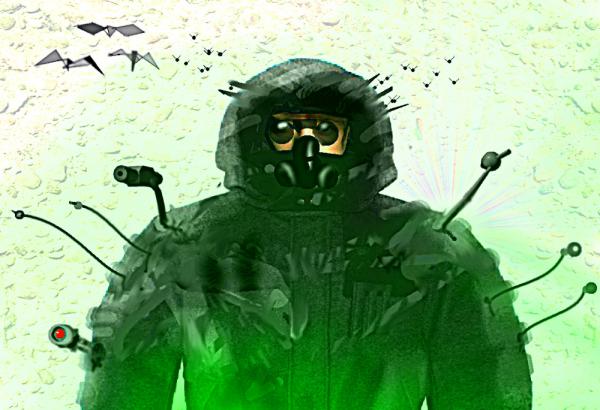BY LETTER
Combat Jacket
Technology > Application > Weapons > Personal Weapons
Technology > Application > Weapons > Surface Weapons
Culture and Society > Politics & Government > Warfare
Technology > Application > Weapons > Surface Weapons
Culture and Society > Politics & Government > Warfare
 Image from Steve Bowers | |
| Wearable Multi-gun platform for versatile personal offensive/defensive operations. | |
To counter this various nations and corporations began R&D projects focusing on increasing the capabilities of individual soldiers (though various transapients used bizarre chaotic tactics to make increasingly complex yet increasingly stronger armies). This lead to a spate of multi-role training and weaponry, one of the most significant developments was that of the Combat Jacket. Resembling a thick hooded coat a Combat Jacket (CJ) is composed of an outer layer of reactive armour weave protecting an inner layer of programmable gel fibres. Within the inner layer a suite of weaponry is to be found that can quickly be moved about the jacket by the gel fibres before being deployed on telescopic, fully prehensile tendrils through orifices that can be formed at any point along the outer layer. The loadout of CJs can vary greatly, below is an example of a typical balanced suite from the early First Federation era:
Weapons
- 1x Stun batton.
- 1x Boomstick.
- 8x Adjustable Memory Blade.
- 1x Electrolaser - 4x 10KW Multi-spectrum lasers
- 2x 5mm Automatic kinetic projectile guns [1].
- 2x Short range dusters.
- 1x Heavy metal squirt.
- 1x 15mm Gauss cannon - 1x Particle cannon.
- 40x Hunter/killer explosive darts [2].
- 8x 40mm Rocket guided ACER rounds
- Full suite of cyberwarfare programs
Equipment
- 200 Nanoflex origami drones
- 1000 synsect drones (various designs: flying, crawling, swimming, burrowing etc)
- Multi-channel communications array
- Multi-spectrum sensor/scanner suite
- Computronium chips hosting tactical AI
- Nanomedical First Aid Kit.
- Superconductive energy storage cells.
- Multiple Uber-widget toolkit
- Deployable Nuclear, Biological, Chemical, Nanotechnological (NBCN) suit
To operate a CJ soldiers had to undergo extensive training to deal with the increased tactical know-how of using so many different weapons all at the same time. Many soldiers failed CJ training programs without extensive intelligent augmentation via military DNIs that granted increased multitasking capability as well as causing a synergistic fusion of the soldier and on-board tactical AI during combat.
Whilst CJs offered a great advance in infantry tactics they found themselves constantly in competition with ever increasingly sophisticated mechs (including wearable exosuits) and cyborgs, both far better platforms for multi-weapon loadouts by including them in artificial/augmented minds/bodies that are fit-for-purpose. In addition super-specialised armies formed by transapients that seem to be immune to the perils of modosophont specialisation, indeed taking out a critical asset will just cause a protean change strengthening the army against further attack.
The development of utility fog based swarm weapons such as Active Polymorphic Defences were the nail in the coffin for CJs and indeed almost all modosophont infantry. Having said this throughout history CJs have seen use in various wars in midtech civilisations and still are favoured in many societies for personal defence and/or sporting reasons.
- With multi-function ammunition: capable of assuming a variety of shapes for armour piercing or antipersonnel. Contains fluid which can be quickly modified by in-built nanomechanisms to assume a variety of toxins or become highly explosive.
- Launched from a rack before deploying to ornithopter mode with rocket booster: capable of adjustable explosion as well as proximity fuse and remote detonation.
Related Articles
Appears in Topics
Development Notes
Text by Ryan B
Initially published on 10 March 2012.
Initially published on 10 March 2012.






